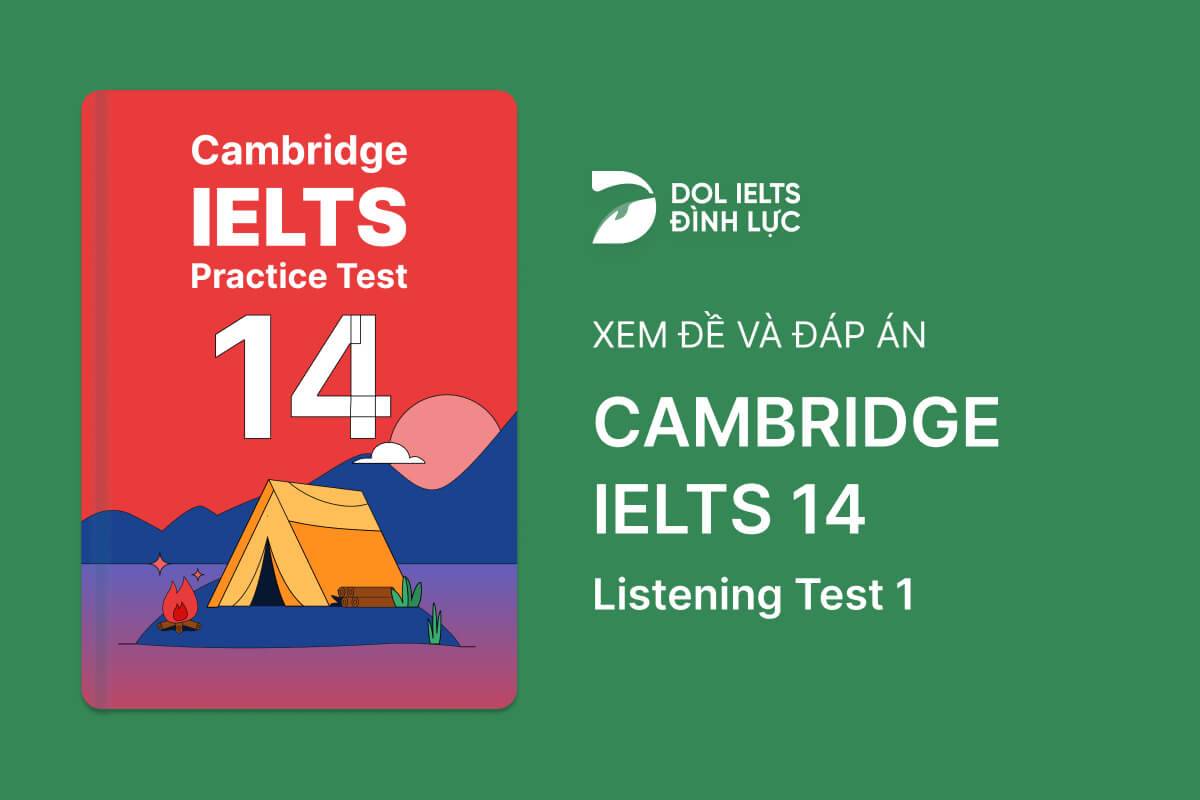Cambridge IELTS 14 - Listening Test 1 With Practice Test, Answers And Explanation
Luyện tập đề IELTS Online Test Cambridge IELTS 14 - Listening Test 1 được lấy từ cuốn sách Cambridge IELTS 14 với trải nghiệm thi IELTS trên máy và giải thích đáp án chi tiết bằng Linearthinking, kèm answer key và list từ vựng IELTS cần học trong bài đọc.
Section
👂️ Bài nghe section 1
Lenght of stay two months
❓ Tapescript section 1
🔥 Đáp án & giải thích section 1
Giải thích chi tiết
 Xác định từ cần điền là noun chỉ quốc tịch của Louise.
Xác định từ cần điền là noun chỉ quốc tịch của Louise.
 Khi bạn nghe "And are you resident in the UK?" (Và bạn đang cư trú tại Vương quốc Anh phải không?) là biết đáp án chuẩn bị vào.
Khi bạn nghe "And are you resident in the UK?" (Và bạn đang cư trú tại Vương quốc Anh phải không?) là biết đáp án chuẩn bị vào.
 Sau đó nghe, " No, I’m actually Canadian" (Không, tôi là người Canada)
Sau đó nghe, " No, I’m actually Canadian" (Không, tôi là người Canada)
>> Từ cần điền là "Canadian" 
Section
👂️ Bài nghe section 2
❓ Tapescript section 2
🔥 Đáp án & giải thích section 2
Giải thích chi tiết
 Khi bạn nghe "I’d like to start with some general advice about being an apprentice." là biết đáp án chuẩn bị vào.
Khi bạn nghe "I’d like to start with some general advice about being an apprentice." là biết đáp án chuẩn bị vào.
 Sau đó nghe "The important thing is to check with someone if you’re not sure what to do – you’ll find your supervisor very approachable and won’t mind explaining things or helping you out."
Sau đó nghe "The important thing is to check with someone if you’re not sure what to do – you’ll find your supervisor very approachable and won’t mind explaining things or helping you out."
>> Điều quan trọng là kiểm tra với ai đó nếu bạn không chắc chắn phải làm gì - bạn sẽ thấy người giám sát của bạn rất dễ gần và sẽ không ngại giải thích mọi thứ hoặc giúp bạn
>> Chọn C 
Section
👂️ Bài nghe section 3
❓ Tapescript section 3
🔥 Đáp án & giải thích section 3
Giải thích chi tiết
 Sau khi nghe "I’m glad we chose quite a specific topic – cities built next to the sea" là biết đáp án chuẩn bị vào.
Sau khi nghe "I’m glad we chose quite a specific topic – cities built next to the sea" là biết đáp án chuẩn bị vào.
 Nhiều bạn nghe "And cities are growing so quickly – I mean, we know that more than half the world’s population lives in cities now." thì có thể chọn câu A(contain nearly half the world’s population)
Nhiều bạn nghe "And cities are growing so quickly – I mean, we know that more than half the world’s population lives in cities now." thì có thể chọn câu A(contain nearly half the world’s population)
>> Nhưng ở phía dưới Rob đã nói rằng số liệu "half the world's population" là tất cả các thành phố.
 Sau đó nghe "most of the biggest cities are actually built by the sea"
Sau đó nghe "most of the biggest cities are actually built by the sea"
>> Đáp án là câu B (include most of the world’s largest cities) 
Section
👂️ Bài nghe section 4
renewable energy sources
methods that won’t create pollution
waves can move in any
33
movement of sand, etc. on the
of the ocean may be affected.34
will be created in a
at Swansea36
breakwater (dam) containing 16 turbines
rising tide forces water through turbines, generating electricity
stored water is released through
, driving the turbines in the reverse direction37
not dependent on weather
no
is required to make it work38
likely to create a number of
39
may ham fish and birds, e.g. by affecting
and building up silt40
❓ Tapescript section 4
🔥 Đáp án & giải thích section 4
Giải thích chi tiết
 Xác định từ cần điền là noun chỉ sự gia tăng nào đó là nguyên nhân của việc cần nhiều năng lượng
Xác định từ cần điền là noun chỉ sự gia tăng nào đó là nguyên nhân của việc cần nhiều năng lượng
 Khi bạn nghe "Producing enough energy to meet our needs has become a serious problem."
Khi bạn nghe "Producing enough energy to meet our needs has become a serious problem."
>> Sản xuất đủ năng lượng để đáp ứng nhu cầu của chúng ta đã trở thành một vấn đề nghiêm trọng.
>> Khả năng là không sản xuất đủ nên cần sản xuất thêm, có thể sắp có đáp án cho câu này.
 Sau đó bạn nghe "Demand is rising rapidly, because of the world’s increasing population and expanding industry"
Sau đó bạn nghe "Demand is rising rapidly, because of the world’s increasing population and expanding industry"


